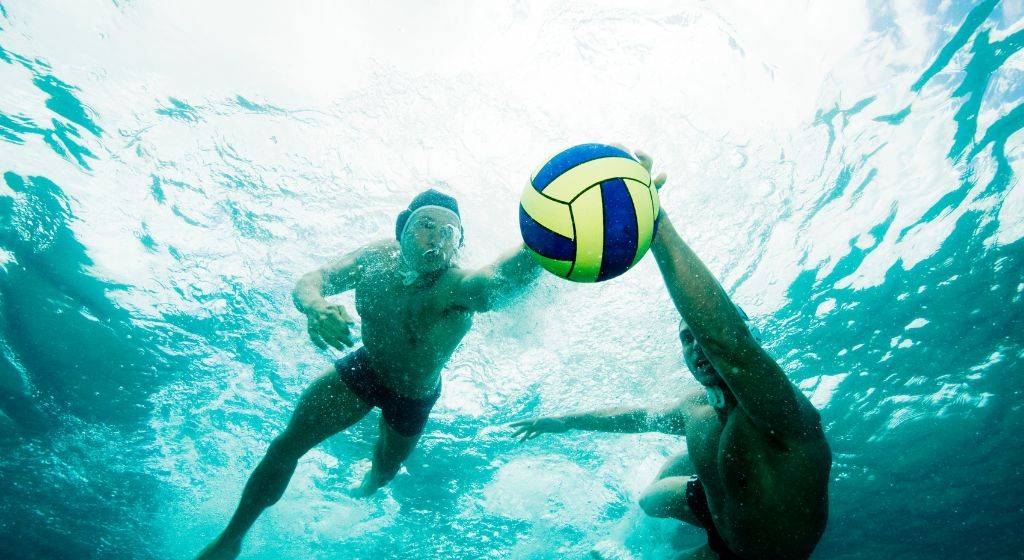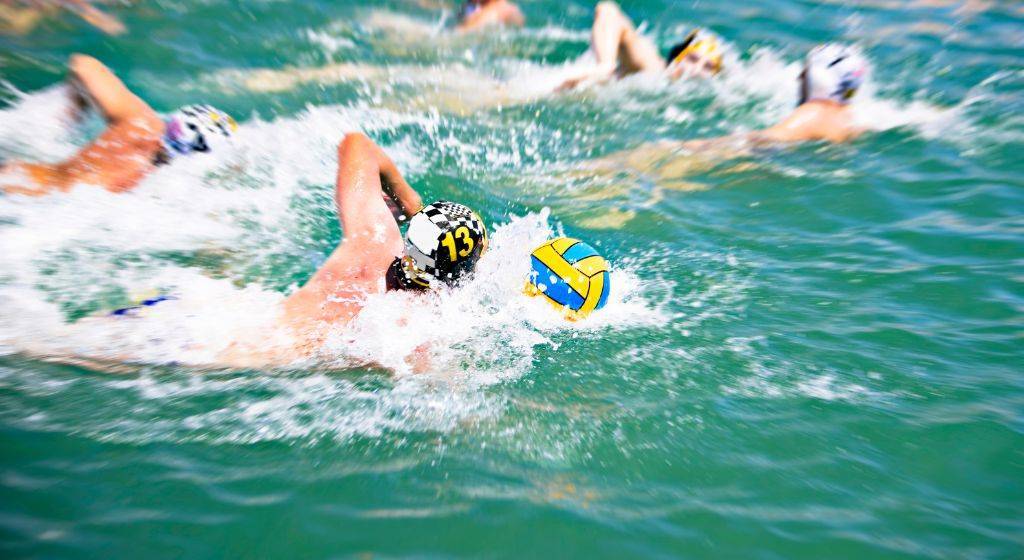Water polo, is perhaps the most popular team water sport. It bears some similarities to handball, both in the number of players and in certain aspects of the rules. However, water polo was originally seen as a kind of water football intended to promote swimming.
If you are interested, don’t forget to visit our last post about adapted sport for people with disabilities!
What is water polo?
In water polo, two teams, each consisting of 6 players and 1 goalkeeper, compete to score goals in the opposing team’s goal. The two goals are placed one at each end of a pool measuring 30 metres long and 20 metres wide for men’s international categories and 25 metres long and 17 metres wide for women’s international categories. The depth of the pool must be a minimum of 2 metres and a maximum of 3 metres. In this way the players will not be able to stand up, but they will have enough distance to perform, for example, the eggbeater kick.
This technique is widely used in water polo as well as in other aquatic disciplines. It consists of making alternating circular movements with each leg, so that one turns clockwise and the other anticlockwise, always with the back straight. It is necessary both for moving and for rising and descending, as well as for carrying weight. Hence its use in other water sports, such as synchronised swimming, where it is used to carry other partners to lift and throw them, or lifeguarding, for the same reasons.
The aim
In water polo, the aim is to score as many goals as possible during the four halves of the game. Each half lasts eight minutes, with two minutes between each half. To do this, players throw and pass the ball to each other with their hands, which they cannot hold for more than three seconds. Although it is also allowed to swim with it, it is only allowed to swim for a maximum of three strokes before throwing and passing it. This ball is similar to a football. It weighs between 400 and 500 g and has a circumference of between 71 and 78 centimetres. The material, on the other hand, must of course be waterproof, without seams or protrusions.
History of water polo
To find the origin ofwater polo we must go back to the end of the 19th century in Great Britain, since, according to some authors, it emerged in Glasgow between 1869 and 1870.
According to these historians, water polo was created from a game called “water polo”because of its similarity to traditional polo, a very famous sport played in the country. In water polo, the players were placed in an empty barrel that allowed them to float in the water. To move around they used an oar, which in turn allowed them to move the ball with the same purpose of scoring goals against the opposing team. Initially, it was not played in swimming pools, but in other bodies of water, whose turbidity often allowed the players to hide the ball and dive with it to the opponent’s goal.
Far from being considered a sport, it was a game, and its purpose was to entertain spectators during the intervals of nautical competitions. Over time, however, it spread throughout the UK, and in 1885, the London Swimming Association eventually recognised it as a sport, while introducing some regulation for its practice.
It soon began to spread worldwide, reaching countries as far and wide as Hungary, Belgium, Germany, Austria, France and the United States. This notoriety reached its peak with the inclusion of water polo in the Paris Olympic Games in 1900.
Olympic Games
As we can see, it did not take long for water polo not only to become popular, but to consolidate itself. National and international championships all over the world are proof of this, as well as its inclusion in the Olympic Games. The women’s category, however, would have to wait almost 100 years, as it was not included in the Olympic Games until 2000.
Although in the early years, as might be expected, the prevalence of the United Kingdom as champion was undisputed, other countries soon began to snatch both titles and Olympic medals. So much so that the British did not win another medal since 1920, and it was instead the Serbs and Hungarians who began to win them. Today, it is these two countries that have excelled the most in the men’s category, and the United States and Italy in the women’s category.

What makes water polo an all-round sport
Water polo is a complete sport that offers a wealth of physical and mental benefits. As we have seen, the simple act of staying afloat in the water involves several muscles, both in the legs and the hips. Throwing and passing the ball, on the other hand, also exercises the arms. For all these reasons, water polo requires a high level of endurance, but also strength and speed.
Equally requiring swimming skill, the sport improves cardiovascular health and increases lung capacity. But we should not overlook the aspects that make water polo a beneficial sport for mental health. Like all team sports, it stimulates coordination and solidarity, improves social and communication skills, and helps to increase concentration and mental agility.
Although it is a demanding sport, with certain adaptations and modifications it can be practised at any age and for any level of ability.
Waterpolo at sea
Sea water has certain characteristics that can make it difficult to practice water polo, such as salinity, currents, wind, waves… Its greater density, however, favours it. For this reason, in areas where the conditions are suitable for its practice, it can be a sport that is not only suitable, but also recommendable. In fact, there are floating goals and balls specifically designed for salt water. So much so that there are even championships for this discipline.
Waterpolo beach
Beach water polo is a variant of water polo played in the sea. For this discipline, the playing field is 15 metres long by 11.5 metres wide and the teams are made up of 4 players each, including the goalkeeper. The matches last between 20 and 30 minutes, and the winner is the team that scores 5 goals. There are, however, no standardised rules for this sport, the rules of which can vary from one competition to another.
In summary, although it is not the most common form of water polo, it is possible to play in the sea and there are some tournaments that are played in the sea.
It is therefore a more informal and somewhat less demanding variant, which has gained popularity and followers in coastal countries, especially in the Mediterranean during the summer seasons
Where there’s water, there’s waterpolo
As we have seen, waterpolo is a sport that is as fun as it is versatile, demanding but inclusive, complete but entertaining. Its benefits for physical and mental health are many and varied. If we also practice it in the sea, in its beach waterpolo variant, we will also enjoy the positive aspects that salt water brings to our skin and our organism in general. And now, with spring just started, it is the best time to try a unique and new experiences like this one. We can’t wait to try it. And after learning a little more about beach water polo, we’re sure you are too.
Referencias consultadas
- Wikipedia (s/f). Water polo.https://es.wikipedia.org/wiki/Waterpolo
- Parra Jesús, R. et á (2006). Aproximación histórica del waterpolo.De los orígenes lúdicos al más alto nivel competitivo mundial y español. Recuperadode https://raco.cat/index.php/ApuntsEFD/article/view/300866
- Wikipedia (s/f). Waterpolo en los Juegos Olímpicos.https://es.wikipedia.org/wiki/Waterpolo_en_los_Juegos_Ol%C3%ADmpicos
- Pelotas (s/f). Pelota de water polo. Recuperado de https://pelotas.com.es/pelota-de-waterpolo/





